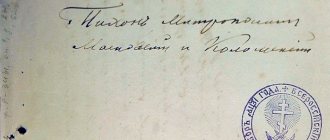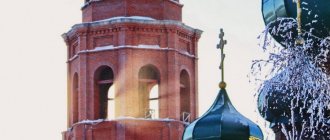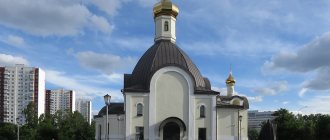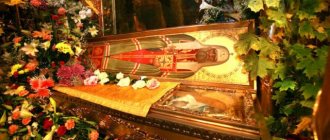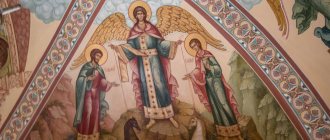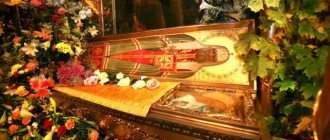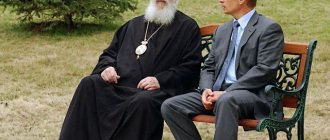Church of St. Tikhon
Home page | About the city Date of publication: May 2007, updated May 31, 2016
The Orthodox Church in honor of St. Tikhon, Patriarch of All-Russia is located at the entrance to the city of Moscow
Events: — A bread shop opened at the Church of St. Tikhon - On the territory of the Church of St. Tikhon, an enclosure with squirrels appeared - The Church of St. Tikhon has a new rector - A list of the icon of the Mother of God from Athos was brought to Moscow - 2 holidays. 400 years since the memorable events - New icons in the Church of St. Tikhon - Holy Resurrection of Christ. Easter, 2012 - Holy Saturday - Important events in the life of the Church of St. Tikhon - Two important events took place in February... - Orthodox Book Day - The Feast of the Epiphany took place, 2012 (video) - Children's Christmas party took place, 2012 (video) - Nativity of Christ , 2012 - Solemn liturgy dedicated to the feast of the Kazan Icon of God, 2011 - Patronal feast of the Church of St. Tikhon, 2011 - Holiday Day of Family, Love and Fidelity, 2011 - Day of Slavic Literature and Culture, 2011 - Great Orthodox holiday Easter, 2011 - Day of the Orthodox Book , 2011 - In January 2011, Dmitry Medvedev visited the Church of St. Tikhon, also see Moscow on television - Day of Family, Love and Fidelity, 2010
Time flies by. It seems that quite recently there was no talk about the fact that Moskovskoye would have its own church. And today there is a temple complex at the very entrance to the city.
In 2003, Metropolitan Juvenaly of Krutitsky and Kolomna consecrated the Church of St. Tikhon in the city of Moscow. This event became significant for the entire Vidnovsky deanery, since for the first time in the Leninsky district the consecration was carried out by the Metropolitan.
Divine services in the church, as a rule, are held daily starting from Wednesday (with the exception of major Orthodox holidays that fall on the first days of the week). On Monday and Tuesday there is a priest on duty in the temple. The exact schedule of services for each week can be found on the temple website.
Every Saturday at 12:00 the sacrament of Baptism
.
The sacrament of weddings
is performed on Mondays, Wednesdays, Fridays, Sundays, when there is no fasting and great holidays, by prior arrangement.
There is a church shop on the territory of the temple.
At the temple there are:
- Sunday School
- Youth organization (every Sunday at 15:00 - questions about faith and the Church, family, etc.);
- Library of Orthodox spiritual literature (Saturday, Sunday from 12:00 to 14:00). The library is located in the Sunday school building;
- pilgrimage service (monthly trips to holy places: churches, monasteries, estates, holy springs), tel. 8 910-418-65-99
- Social service
Saint Tikhon, Patriarch of Moscow and All Rus', was elected head of the Russian Orthodox Church at the All-Russian Local Council of 1917, when the patriarchate, abolished under Peter the Great, was restored. The path of service of the new patriarch began in a difficult and tragic period of church persecution and schisms that followed the change in the political system. Despite many trials, Saint Tikhon remained true to his convictions and zealously ensured the preservation of the purity of Orthodoxy. He called on the flock not to armed struggle, but to repentance and prayerful feat: “Resist them with the strength of your faith,” Tikhon cried. The Patriarch said about himself: “I am ready for any suffering, even death, in the name of the faith of Christ.” He humbly entrusted the fate of the Church, his flock and his own fate to the will of God and believed that it alone was salvific. His Holiness Patriarch Tikhon is considered the heavenly patron of our long-suffering country.
The history of the parish in honor of St. Tikhon in Moskovskoe, where there has never been an Orthodox church since its founding, has also been difficult to develop. This circumstance upset the believing residents of the city, so in 1994 a group of Orthodox Christians, with the blessing of the dean of the Vidnovsky district, Abbot Tikhon, and with the full support of the public, began active work aimed at organizing an Orthodox parish. With God's help, already at the end of November of the same year, an Orthodox community was organized, headed by Nadezhda Fedorovna Godovanets.
With the blessing of the Administrator of the Moscow Diocese, Metropolitan Juvenaly, the parish was named in honor of St. Tikhon, Patriarch of All Russia.
Initially, services were held in an apartment in one of the city's houses. Priest Dionisy Zolotukhin was appointed the first rector of the temple, and a few months later he was replaced by priest Dionysius Batarchuk.
The construction of the small church was completed by the patronal feast of St. Tikhon - October 9, 1996, and on October 16, Abbot Tikhon laid the foundation stone for the large church.
People flocked to the church. On holidays, the small room could not accommodate everyone who wanted to pray. People were looking forward to the opening of the new temple. By April 2000, when management of the parish was transferred to the current rector of the temple, priest Afanasy Chernoguz, the walls and main dome of the large temple were built, and a cross was installed. Under the leadership of Father Afanasy, a huge amount of work was carried out: the temple was completed, decorated inside and out, equipped with everything necessary. In the morning and evening on the days of worship, the city is filled with the ringing of church bells. On your first visit, you remember the decoration of the temple - a high-quality heated granite floor, a three-tiered iconostasis copied from an ancient model, the Royal Doors decorated with magnificent carvings, and an impressive chandelier illuminating it all.
The temple became an integral part of the city. More and more young and old Christians are attending weekly services. Among the regular parishioners are not only residents of Moscow, people come and come from other towns and surrounding villages. Every Saturday the sacrament of Baptism is performed in the church. Deceased Orthodox residents of the village are seen off on their last journey after the funeral service has been performed. Many couples enter into church marriage; almost every week, both newlyweds and people who have already lived together for many years get married. For those who want to know more about Orthodoxy, Sunday School classes are held.
A house was built on the territory of the temple, which housed: a Sunday school, a refectory, and the abbot’s office. The improvement of the church grounds continues.
Source: newspaper article, photo bvn
Twice Born
The diocesan house (house No. 6 in Likhov Lane) in the city of Moscow stands at the origins of the feat of the new martyrs and confessors of the Russian Church.
It was built with the goal of uniting the spiritual forces of Orthodox people 15 years before the social catastrophe of 1917, as if in anticipation of impending events - as the spiritual and missionary center of the Moscow diocese . Various courses, meetings, concerts, services with folk singing, our own printing house and publishing house, Orthodox societies, etc. - all this helped a large number of caring people to get involved in church life and activities, to work for the enlightenment and spiritual education of the people.
It is no coincidence that meetings of the Local Council of the Russian Orthodox Church were held here in 1917. The huge hall, which is a continuation of the magnificent temple in honor of the holy Equal-to-the-Apostles Prince Vladimir, has since become known as the Cathedral Chamber. More than half of its participants were soon repressed, and the Diocesan House itself was “expropriated”: plundered and mutilated beyond recognition by perestroika.
Many meetings of the Local Council of the Russian Church (1917-1918) were held in the Diocesan House of Moscow, it was here that the historic decision to elect a patriarch was made
Archpriest Vladimir Vorobyov, Rector of PSTGU with a team of icon painters who painted the premises of the Diocesan House, in the Church of St. Prince Vladimir, where, at one time, the Local Council was held. Photo from pstgu.ru
Forests and frescoes
Today, from the walls of the restored Cathedral Chamber, those who, under the roar of revolutionary cannonade, voted for the restoration of the Patriarchate in the Russian Church are looking: the first martyr among the bishops - Metropolitan Vladimir (Epiphany), builder of the Diocesan House in Moscow, St. Tikhon, soon elected All-Russian Patriarch, Metropolitan Benjamin of Petrograd (Kazansky), Metropolitans Kirill (Smirnov), Agafangel (Preobrazhensky), who became candidates for locum tenens of the patriarchal throne, Locum tenens after the death of St. Tikhon - Metropolitan Peter (Polyansky), Elder Hieroschemamonk Alexy the Recluse (Soloviev), who drew lots for the patriarchate to St. Tikhon.
Irina Shchelkacheva, assistant to the rector of PSTGU:
— Until 1902 in Moscow, even for the annual diocesan meeting it was necessary to rent a hall in the Assembly of the Nobility. And so, with the blessing of the Moscow Metropolitan, the future Hieromartyr Vladimir (Epiphany), the construction of the Diocesan House “as a center of religious education, educational, publishing and missionary activity” was begun and completed in 1902.
The Vysoko-Petrovsky Monastery gave its land for construction.
Diocesan house after transfer to the Bolsheviks, early 20th century. From 1924 to 1992, the building of the Diocesan House belonged to the Soviet state, from 1992 to 2004 it passed into private hands. In 2004, after 40 court hearings (30 losses, 10 wins), it was decided to return the Church House
The house and temple in Likhov Lane were built with church money (although members of the royal family were among the donors for the construction).
This house was huge for those times, and many different societies immediately settled here, led by the already mentioned Society of Lovers of Spiritual Enlightenment.
An extensive diocesan library with a reading room for everyone was moved here, the editorial offices of the spiritual magazines “Moscow Church Gazette” and “Sunday Conversations” were located here, the Brotherhood of St. Peter, the Cyril and Methodius Brotherhood, the Missionary Society, known throughout Russia for its activities among the foreigners of Siberia, gathered here, Japan, China, America.
2021
The house housed the diocesan school council, the department for the distribution of spiritual and moral books, the guardianship of the poor clergy, which was in charge of almshouses and shelters, the spiritual censorship committee, the church-archaeological museum with unique collections of church antiquities, the committee for collecting church utensils, sending out necessary liturgical items to poor churches. This listing of societies and their activities allows us to understand today how much work the Church had.
Since 1918, the Orthodox People's Academy was opened in the Diocesan House, the heirs of which today are PSTGU. It was a unique educational institution that combined higher theological education with secular education. Unfortunately, it existed here for only two months... In a word, until the revolution itself there was a center for the fight against the advancing godlessness.
Foundation of the temple in the building of the prison castle
In 1863, provincial secretary Stepan Mikhailovich Poryvkin, a teacher of calligraphy and drawing at the Klin district school, submitted a petition to the vice-president of the Moscow Committee of the Trusteeship Society for Prisons regarding his desire to establish a house church in the Klin prison castle. (In prison, Stepan Mikhailovich taught the prisoners to read and write.) On October 29, 1863, the vice-president of the Moscow Committee submitted a petition to the Metropolitan of Moscow and Kolomna Philaret that the provincial secretary Poryvkin had the desire to build a house church through voluntary landscapers (his acquaintances), and therefore he asks for intercession to bring this desire into fulfillment. In response to this request, on November 29, 1863, the Moscow Ecclesiastical Consistory ordered the dean to inspect the proposed area for the construction of a house church in the Klin prison castle, followed by a report to the Consistory.
The dean and rector of the Klin Trinity Cathedral, Archpriest Sergius Modestov, in his report in response to this request, writes that the church is supposed to be built on the second floor of the prison building, next to the cells for pre-trial prisoners.
On February 5, 1864, a decree followed “His Imperial Majesty, Autocrat of All-Russia... synodal member His Grace Philaret, Metropolitan of Moscow... to authorize the establishment of the proposed church in the name of St. Tikhon of Voronezh,” so that it would be transferred to the jurisdiction of the clergy of the Klin Trinity Cathedral. The choice of the patron saint of the temple was not accidental: during his lifetime, Saint Tikhon diligently helped the orphaned and disadvantaged, often visited prisoners in prison, supported them and instructed them in the word of God.
On October 18, 1864, the house church was consecrated by the Archpriest of the Moscow Archangel Cathedral, Peter Pokrovsky.
Every tenth person is a martyr
Many members of the Council suffered martyrdom, about 50 (that is, every tenth) of them were canonized.
Today, from the walls of the restored Cathedral Chamber, those who voted for a new choice for the history of the Russian Church - the Patriarch (already under the roar of shells, even plaster was falling) are looking. Persecution of the Church and reprisals against priests were discussed already at the third session of the Council of 1917-1918. It began with a memorial service for the murdered Tsar Nicholas II and ended with the reading of the first martyrology of the new martyrs who suffered under Soviet rule.
According to this list, by the end of the meetings of the Council, 121 members of the Russian Orthodox Church suffered for their faith, 118 people were in prison. Among the new martyrs were named Metropolitan of Kiev Vladimir (Epiphany), Bishop of Tobolsk Hermogenes (Dolganev), Bishop of Oryol Macarius (Gnevushev) and Bishop of Kirillov Varsanuphius (Lebedev); two archimandrites; eight archpriests, including Philosopher Ornatsky, rector of the Kazan Cathedral in Petrograd, and John Vostorgov, rector of St. Basil's Cathedral on Red Square in Moscow; 20 priests; 8 monks and 7 laymen. Among the new martyrs, whose names were not known, there were 7 priests and 18 laymen.
View of the Cathedral Chamber from the central part of the Vladimir Cathedral. Photo: Deacon Andrey Radkevich
In September 1918, the work of the Local Council was forcibly stopped: the Bolsheviks took away the building. Subsequently, many members of the Council suffered and suffered martyrdom, about 50 (that is, every tenth!) of them are now canonized.
Icon of the Council of New Martyrs of the Members of the Local Council in 1918
On November 17, 2008, on the eve of the day of remembrance of Patriarch Tikhon, a cross was installed over the restored golden dome of the Prince Vladimir Church, and regular services began in the lower church. The raising of the cross is a solemn moment and a breathtaking spectacle - such joy!
Photo: Deacon Andrey Radkevich
In February 2010, His Holiness Patriarch Kirill visited the Diocesan House. He said firmly: “This house needs to be restored!” and provided decisive assistance, without which it would not have been possible to consecrate the renovated Diocesan House and the Prince Vladimir Church for the 1000th anniversary of the Holy Equal-to-the-Apostles Prince Vladimir in 1915.
